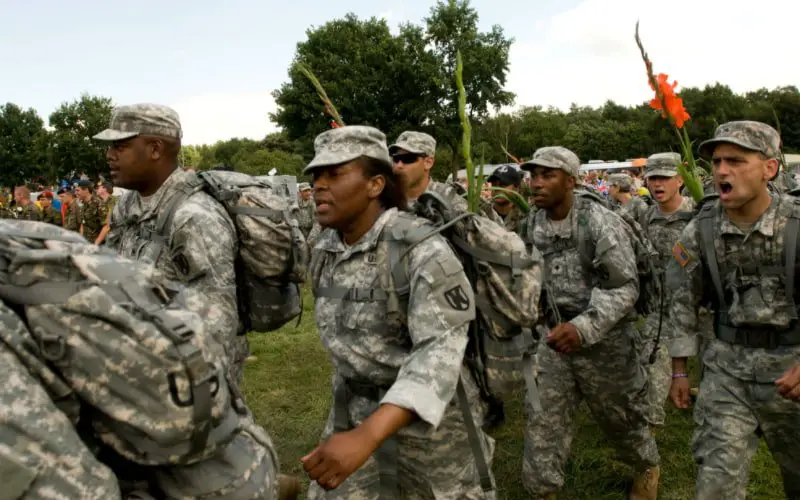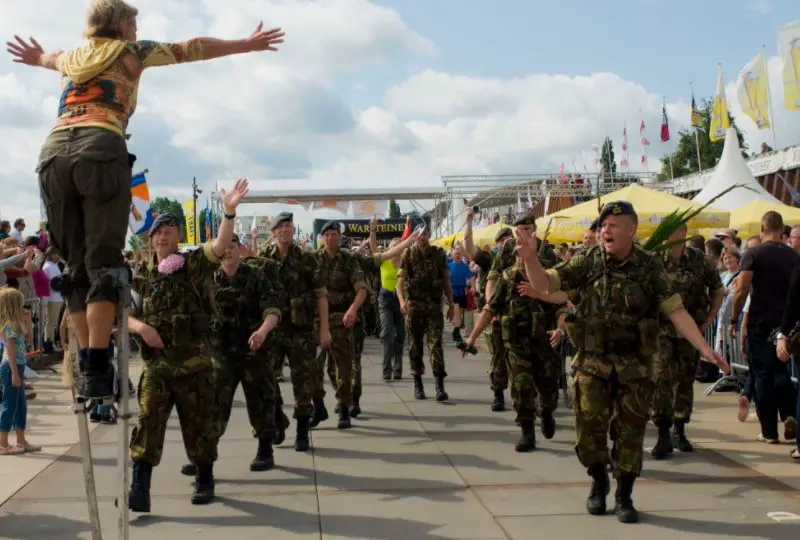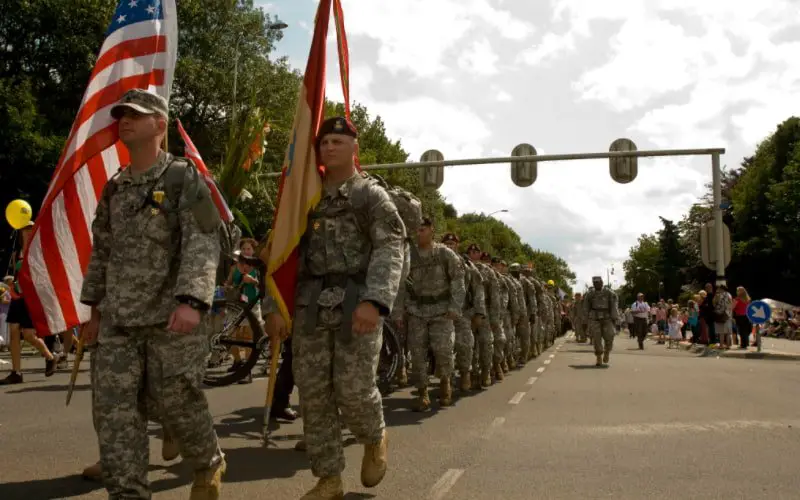

Almost every walking enthusiast has heard of the Nijmegen Four Days Marches. It is the largest walking event in the world. This enormous event is more than a hundred years old and knows a rich history. In this blog, the history of the Four Days Marches will of course be discussed, although there is much more to tell. So, keep on reading to find out everything about the Nijmegen Four Days Marches.
The Nijmegen Four Days March is the biggest walking event in the world. For four days, a distance of 30 km, 40 km, or 50 km is covered every day. The march originated in 1909 as an event for the military. Nowadays anyone is welcome to join and walkers from more than 70 different countries walk along.
The Nijmegen Four Days Marches is an amazing event that always brings a fantastic atmosphere. That’s why it’s definitely recommended to be there every year during the third week of July in Nijmegen! In this blog, you’ll find out what it is that makes this event so special!
The Nijmegen Four Days Marches is a walking event that is organized each year in and around the city of Nijmegen. Nijmegen lies in the south-east of the Netherlands and is considered the oldest city in the Netherlands.
Where the Four Days Marches used to be intended for the military only, it has now grown into the largest walking event in the world, where everyone can participate.
There are three different distances someone can choose from, these are 30 km (18 miles), 40 km (24 miles), or 50 km (31 miles). The participants must cover the distance they have chosen for four consecutive days. The walkers do walk a different route each day, but I’ll be talking more about that later on in this blog.
There are however a couple of rules one must adhere to depending on each distance.
For example, there are rules that determine what minimum distance a certain age and gender should walk. Below you’ll find a table containing these criteria.
| Men’s: | 30 km (18 miles) | 40 km (24 miles) | 50 km (31 miles) |
| 12 - 15 years | Min. distance | Allowed | Allowed |
| 16 - 18 years | Not allowed | Min. distance | Allowed |
| 19 - 49 years | Not allowed | Not allowed | Min. distance |
| 50 - 59 years | Not allowed | Min. distance | Allowed |
| 60+ years | Min. distance | Allowed | Allowed |
| Women’s: | 30 km (18 miles) | 40 km (24 miles) | 50 km (31 miles) |
| 12 - 15 years | Min. distance | Allowed | Allowed |
| 16 - 59 years | Not allowed | Min. distance | Allowed |
| 60+ years | Min. distance | Allowed | Allowed |
As you can see, there are minimum distances that you’re required to walk for each age category. There are a couple of exceptions, for example, a parent walking along with their child. In this case, the parent is allowed to walk the same distance along with the child, but the parent won’t receive a “Vierdaagsekruisje” (reward for finishing).
During the Four Days Marches, the walkers will be encouraged by thousands of people standing along the side. Music is being played, people are dancing and celebrating, but tears will also be shed.
The Four Days Marches is an enormous war of attrition and demand the utmost of your body and mind. Even the most experienced walkers can face extreme difficulties and often see no other option but to quit.
That’s why the audience along the side is so important; they can make the difference in making sure someone who is struggling will still be able to cross the finish line.
Unfortunately, some walkers don’t make it to the finish. This is usually due to injuries and blisters. There are First Aid posts everywhere along the route trying to cure these blisters and injuries, but unfortunately, sometimes it’s so bad for walkers that they are forced to quit.
Fortunately, most walkers are able to finish the Nijmegen Four Days Marches. It’s been said that after your first time, you’re either addicted to it, or you’ll never want to do it again in your entire life.
The former is absolutely true for the Dutchman Bert van der Lans. He managed to finish the Nijmegen Four Days Marches an astonishing 71 times! This makes him the record holder to have successfully finished this walking event many times.
At the Nijmegen Four Days Marches, it’s all about performance and everything around it. Each year some walkers make it a challenge to be the first to cross the finish line, something the organization absolutely doesn’t stimulate. These walkers reach the finish so early, that there’s not even anyone standing in the audience yet.
Moreover, it is not allowed to speed walk during the Four Days Marches. If it does happen, the participant will be disqualified.
The largest portion of the participants are walking enthusiasts and people who feel like they want to challenge themselves. Of course, many people see the challenge as the most important aspect, but it is also the atmosphere alongside the road which plays an important role for participants.
The famous "Waalbrug" in Nijmegen, which is crossed twice on day 1:

As I mentioned before, the Nijmegen Four Days Marches have existed for over 100 years. The first edition of the walking event was held on the 1st of September, 1909. During this edition, 306 people participated. All of them, except 10 citizens, were from the military.
During this first edition, a total of 140 kilometers (87 miles) was traveled in four days, and walkers only returned to where they started on the final day.
Below you will find a timeline with the different events and exceptions which have occurred at the Nijmegen Four Days Marches throughout the years:
During these years the Four Days Marches didn’t take place, due to the mobilization of World War I.
From 1925 Nijmegen became the set starting location of the Four Days Marches. Before this, people could choose between 12 other starting locations. Since 1925, all routes lie in and around Nijmegen. The distances people could pick from at the time were: 35 km (21 miles), 45 km (27 miles), and 55 km (34 miles) a day.
During this edition, a member of the Dutch royal family walked along. It was Prince Claus, husband of former Dutch Queen Beatrix.
From this year, the distances were also changed to the ones we know of today: 30 km (18 miles), 40 km (24 miles), or 50 km (31 miles).
Due to hot temperatures, the distances of this edition were shortened.
This was the year in which the millionth participant walked the Nijmegen Four Days Marches.
In 2003, temperatures were again so high that the distances had to be shortened.
A tragic year for the Four Days Marches. After the first day, the Four Days Marches were canceled due to the extreme heat. As a result of the hot temperatures, the emergency services couldn’t handle the situation, and two participants even died.
The final day is usually the most festive of all. However, in 2014 this day ended up being a sad day due to the plane crash of flight MH17 a day earlier. The passengers of this plane were mostly Dutch.
Out of respect for the victims, there was no music during the entry of the event and there was a minute of silence.
In this year, it was for the first time that the 1.5 millionth “vierdaagsekruisje” was awarded.
The 100th edition of the Nijmegen Four Days Marches! Especially for this edition, a one-off extra distance of 55 km (34 miles) was added.
Unfortunately, the organization was forced to cancel this edition due to the worldwide Covid-19 pandemic.
It’s not yet clear whether the edition of 2021 will get the green light due to Covid-19. This will depend on the situation at that moment.
During the Four Days Marches, the walkers travel a different route each day. This route has been the same for years, apart from a few small changes. The participants will walk in different Dutch provinces during this week.
In the places along the route, people are looking forward to the day of the passage of their village months in advance. Every place turns it into one big party, and the local catering entrepreneurs are assured to have one of the best days of the year.
Soldiers partying during the Nijmegen Four Days Marches:

Below you will find a route overview of the four walking days.
The first walking day takes the walkers towards the Betuwe, an area north of Nijmegen. During this day, the walkers will cross the famous Waalbrug right after the start, and once more at the end of the day when they walk back into Nijmegen.
The places which the walkers will pass on the first day of the Four Days Marches are:
Of course, not all distances pass through the same places, so the two longer distances make a loop to achieve the desired number of kilometers.
During the second day of the Four Days Marches, walkers walk towards the places west of Nijmegen. Furthermore, the second day is known as the day with the highest average number of dropouts.
The second walking day is also known as "pink Wednesday". This originated when the route was still going through the streets of Nijmegen, where many gay bars were established. But because of the enormous crowds and congestion in the narrow streets, these are no longer visited.
The theme pink Wednesday hasn’t gone lost, however. Many walkers, but also visitors dress up, and there are many performances dedicated to this day.
The places which the walkers pass on the second day of the Four Days Marches are:
Of course, not all distances pass through the same places, so the two longer distances make a loop to achieve the desired number of kilometers.
The third day takes place south of Nijmegen. This day is very hilly, with the highlight of the day being the infamous seven hills road (zevenheuvelenweg) in Groesbeek.
The many hills are seen as tiresome by a lot of walkers, and cause for a large number of dropouts every year.
A Canadian military cemetery is located halfway along the seven hills road. WWII soldiers who gave their lives for the liberation of the Netherlands are buried here.
The participating military bring a visit to the cemetery on this day, to pay respect to their deceased colleagues.
The places which the walkers pass on the third day of the Four Days Marches are:
Of course, not all distances pass through the same places, so the two longer distances make a loop to achieve the desired number of kilometers.
On the fourth day, the participants also walk on the south and southwest side of Nijmegen. On this day, there’s a couple of places which have also been visited on the third day.
This final day is of course all about reaching the finish line in order to receive that oh-so-desired “vierdaagsekruisje”.
The places which the walkers pass on the fourth day of the Four Days Marches are:
Of course, not all distances pass through the same places, so the two longer distances make a loop to achieve the desired number of kilometers.
The final kilometers of this fourth and last day is walked on the St. Annastraat in Nijmegen, which has been renamed “Via Gladiola” on this day. On this street, the public stands in line, encouraging the walkers to ensure they’ll manage to complete the last few kilometers.
Many walkers have friends or family waiting for them in this street. All of this turns the entry into one big folk festivity in the city.
The name “Via Gladiola” comes from a Dutch saying: de dood of de gladiolen, which basically means: all or nothing.
During the entry, it’s a tradition to give the walkers a gladiolus (a kind of flower) as a gift. As a result, the gladiolus has become the symbol of the Nijmegen Four Days Marches.
As you’ve most likely been able to understand from the text above, the military still makes up for a large chunk of the participants of the Nijmegen Four Days Marches.
The soldiers come from all over the world. In 2019, an astonishing 7.000 soldiers participated in the Four Days Marches, coming from 33 different countries.
During the Four Days Marches, the military stays at camp “Heumensoord”. This is a large terrain in the forest near Nijmegen, adjacent to the military training ground. This camp is huge and looks like a small village. It even has its own fire brigade, health center, and security.
Camp “Heumensoord” in numbers:
Because the camp is located a few kilometers away from the start and finish place, the soldiers always end up walking a few kilometers more than is required. To make the challenge even more difficult, soldiers up until the age of 50 have to carry a 10 kilo (22 pounds) backpack.
The many soldiers accompanying the Four Days Marches give the other walkers and the people on the side a special feeling. These men in uniform walk beautifully in military formation and often sing out loud.
This reminds me of the past when I stood by the side as a little boy and watched the soldiers marching by in admiration. They then gave me beautiful stickers and badges for my collection.
American soldiers marching on the 4th day of the Nijmegen Four Days Marches:

During this largest walking event in the world, it’s not just all about walking. The entire city of Nijmegen, with a total of 177.000 citizens, is devoted to the Four Days Marches.
This means that there are both day and night activities. Think of performances, food trucks, fairs, firework shows, and much more. There’s something to do for young and old, and you can make it as late as you want.
Some partygoers make it so late, that they’re able to wave goodbye to the first walkers of the next day.
The festivities during the Four Days Marches last for the rest of the week and attract many visitors from all over the country. This festive week is called the “zomerfeesten” (summer weeks). In 2019, the “zomerfeesten” attracted a record total of 1.6 million people.
This caused the city to be overly crowded. In some streets and on certain squares it’s so busy that it’s impossible to walk through. However, the atmosphere is always good and there’s never been a major incident.
Together with the Four Days Marches, the “zomerfeesten” ensures that this is an event you wouldn’t want to miss!
Due to the fact that the Nijmegen Four Days Marches is the largest walking event in the world, there are a number of statistics to mention. Below you’ll find an overview of the “Four Days Marches in numbers 2019”.
Statistics of the Nijmegen Four Days Marches 2019:
| Edition: | 103 |
| The total number of participants: | 47.000 |
| The number of military participants: | 7.000 |
| The number of participants start 1st day: | 44.702 |
| Not started on 1st day/dropout: | 661 |
| Finished 1st day: | 44.041 |
| Not started on 2nd day/dropout: | 1.350 |
| Finished 2nd day: | 42.691 |
| Not started on 3rd day/dropout: | 1.111 |
| Finished 3rd day: | 41.580 |
| Not started on 4th day/dropout: | 345 |
| The total number of participating countries: | 77 |
| The number of finished participants: | 41.235 |
I hope that through this blog, you’ve been able to find out what is the Nijmegen march. You now know that it’s the largest walking event in the world and that there are tons of other activities during this week.
Are you a walking enthusiast, or someone who likes to challenge themselves? In that case, the Nijmegen Four Days Marches are absolutely made for you! But, as you’ve been able to read, there’s also plenty of things to experience for the non-walkers!